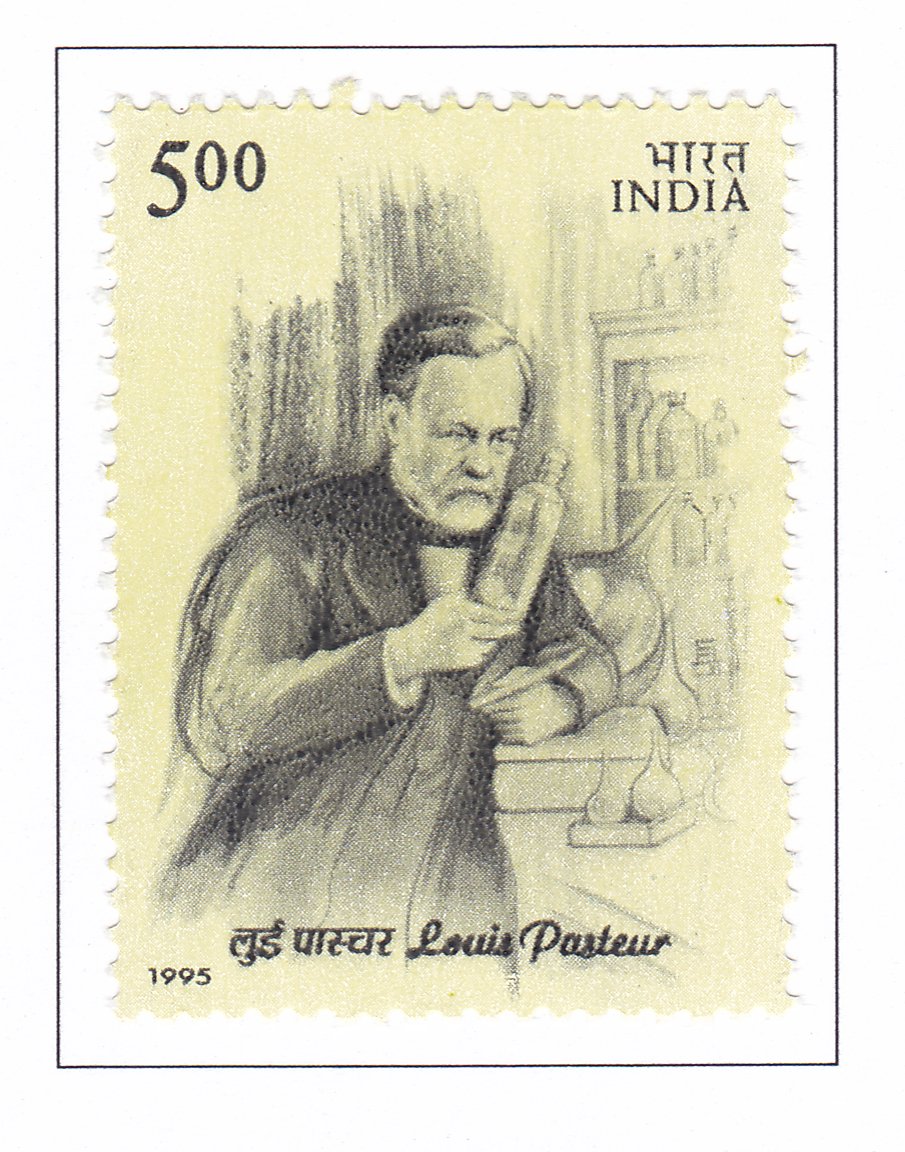Louis Pasteur (1822-1895)

Technical Data
| Date of Issue | September 28, 1995 |
|---|---|
| Denomination | Rs. 5 |
| Quantity | 600,000 |
| Perforation | comb 13 x 13½ |
| Printer | Security Printing Press, Nashik |
| Watermark | No Watermark |
| Colors | Black | Grey |
| Catalog Codes |
Michel IN 1473 Stamp Number IN 1532 Yvert et Tellier IN 1251 Stanley Gibbons IN 1635 |
| Themes | Anniversaries and Jubilees | Art | Chemists | Famous people | Men | Paintings |
Table of Contents
Commemorative Stamp: Louis Pasteur and His Revolutionary Discoveries
Design Elements
- Louis Pasteur at Work: The stamp features an image of Louis Pasteur at work, originally depicted by the Finnish painter Albert Edelfelt and recreated in a charcoal sketch. This iconic image captures Pasteur in the midst of his scientific endeavors, symbolizing his dedication and pioneering spirit.
- Bronze Statue of Jupille: The first day cover showcases the bronze statue of young Jupille, who was vaccinated against rabies by Pasteur. This statue, created by sculptor Jean-Baptiste Auguste Truffaut, stands in the Institut Pasteur in Paris, representing one of Pasteur’s most significant achievements.
Louis Pasteur’s Legacy
- Revolutionizing Multiple Fields: Over the course of 50 years, Louis Pasteur’s discoveries transformed various fields including chemistry, agriculture, industry, medicine, surgery, and hygiene. His contributions are a testament to the profound impact of science on improving the human condition.
- Molecular Asymmetry: In 1847, Pasteur formulated the fundamental law that asymmetry differentiates the organic world from the mineral world, marking a key discovery in stereochemistry, or three-dimensional chemistry.
- Microbiology: Pasteur’s study of fermentation led to the understanding that specific microorganisms cause different types of fermentation. This discovery laid the groundwork for microbiology, enabling the development of techniques to control contamination and kill harmful microbes.
- Pasteurization: His discovery that microorganisms caused wine diseases led to the process of pasteurization, where heating wine, beer, and milk to 55° C killed harmful microbes. This process became globally adopted and remains in use today.
- Silkworm Diseases: Pasteur’s work on silkworm diseases identified infectious agents and transmission methods, further reinforcing his findings that each disease has a specific microbe.
- Infectious Disease and Vaccines: Between 1877 and 1887, Pasteur focused on infectious diseases, discovering staphylococcus, streptococcus, and pneumococcus. He developed vaccines for chicken cholera, anthrax, and swine erysipelas. His most famous achievement came on July 6, 1885, when he successfully tested his rabies treatment on a young boy, Joseph Meister.
- Institut Pasteur: Pasteur’s success led to the establishment of the Institut Pasteur, founded as a center for rabies treatment, infectious disease research, and education. Pasteur dedicated the last seven years of his life to this institution, which continues to carry forward his legacy through the work of his disciples, the Pasteuriens.
Scientific Methodology and Humanism
- Methodological Revolution: Pasteur’s approach to science emphasized the freedom of creative imagination, rigorously subjected to experimentation. His work revolutionized scientific methodology, setting a standard for modern research.
- Humanistic Goals: Louis Pasteur was driven by a deep commitment to improving the human condition. He was a free thinker who challenged the false ideas of his time, always striving to make a positive impact on society.
Commemorative Value
- Global Impact: The stamp commemorates the global significance of Louis Pasteur’s discoveries and their enduring impact on various scientific fields. It serves as a tribute to his contributions to humanity and the advancement of knowledge.
- Educational and Inspirational: This stamp is not only a collector’s item but also an educational resource, highlighting the importance of Pasteur’s work in shaping modern science and medicine.
- Symbol of Innovation: The stamp design, depicting Pasteur at work and the statue of Jupille, symbolizes the intersection of scientific innovation and humanitarian effort that defined Pasteur’s career.
Example of the Stamp Design
- Stamp: The stamp features Louis Pasteur at his desk, engaged in scientific research, with a backdrop that symbolizes the various fields he revolutionized through his discoveries.
- First Day Cover: The cover includes the bronze statue of young Jupille, symbolizing Pasteur’s groundbreaking work in developing the rabies vaccine and his lasting legacy in medical science.
Importance of the Stamp
This special postage stamp honors Louis Pasteur’s 50 years of groundbreaking work that revolutionized science and medicine. It celebrates his contributions to various fields, from microbiology to stereochemistry, and his role in the development of life-saving vaccines. The stamp also highlights Pasteur’s dedication to improving the human condition through rigorous scientific methodology and innovation.
